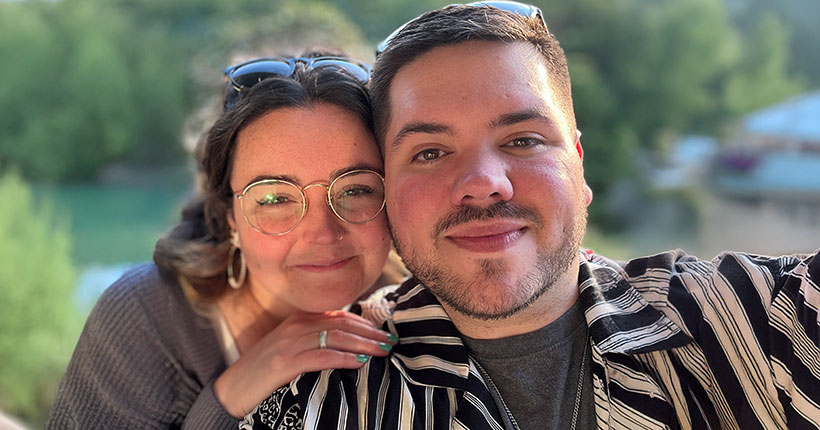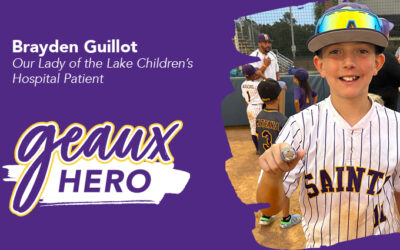In August 2021, Dillon Major was doing everything he could to stay out of the hospital.
He had gone four years without even getting so much as a cold. But then COVID struck, and he knew this time was different.
“With COVID, I just kept getting worse. I couldn’t even walk up and down the stairs,” he recalls.
When his oxygen levels dropped dangerously low — hovering near the 70s — paramedics urged him to get to the emergency room immediately. That decision would mark the start of a life-altering journey through three hospitals, two months in a coma and a long road to recovery.
‘Do What You Gotta Do’
Transferred from Walker, La., to Our Lady of the Lake Regional Medical Center, Dillon was isolated, battling not just illness but withdrawal from nicotine, stress and fear of the unknown. His oxygen levels remained low, even with a CPAP machine.
“I kept pulling the mask off. I felt like I couldn’t breathe,” Dillon recalls. “They told me, ‘If you keep taking it off, we’re going to have to put you on the vent.’” Dillon originally was against the idea because of stories he had read about people going on a ventilator and never recovering. But when hospital staff said his outlook wasn’t promising without the ventilator, he finally had a change of heart.
“I said, ‘Do what you gotta do.’”
That was the last thing Dillon remembered before falling into an induced coma.
Over the next two months, his family was called to the hospital more than once to say goodbye. Doctors were grim. Every day, paperwork hinted at the worst. But behind the scenes, the respiratory care team at Our Lady of the Lake was working around the clock — monitoring, adjusting, advocating and praying with Dillon’s family.
Waking Up to a New Reality
When Dillon finally woke up, he didn’t know how long he’d been asleep. The first thing he remembers was throwing up profusely, but even that felt like a sign of life returning.
“I felt better, weirdly,” he says.
Medical staff worried that the prolonged time without enough oxygen would lead to brain damage, but those fears quickly faded with a case of mistaken identity. Dillon noticed his fiancée had on someone else’s visitor’s badge. Confused, he mouthed the question, trying to ask who was in the picture. It was a small but unmistakable sign that his memory and awareness were intact.
“When I recognized that her name tag had someone else’s picture, they knew I was there. I was aware,” he says
Dillon had to relearn how to do everything: how to move, talk, swallow, eat and eventually, walk. After two weeks in the Progressive Care Unit, he transitioned to inpatient rehabilitation, where the small victories added up — passing a swallow test, removing a tracheostomy tube and eventually standing on his own.
A Ray of Sunshine in the Darkest Days
A turning point in Dillon’s recovery came in the form of his respiratory therapist, Sara Patterson, BS, RRT, who worked with him throughout his hospitalization. Her encouragement and presence provided something many ICU patients go without: hope.
“Sara was an absolute ray of sunshine,” Dillon says. “She really cared. She was excited about my progress, like genuinely happy. When it came time to remove my trach tube, she happened to be visiting and asked if she could do it. That was really special.”
Excellence Recognized: Our Lady of the Lake’s Award-Winning Respiratory Care Center
Dillon’s story is not just one of personal triumph, but also a testament to the level of care at Our Lady of the Lake, which was recently named Hospital of the Year by the Louisiana Society for Respiratory Care.
The award recognizes facilities that demonstrate outstanding outcomes, patient care, innovation and professional development in respiratory therapy. Facilities are also evaluated on how they manage complex cases and support patients through critical respiratory challenges.
Our Lady of the Lake’s Respiratory Care Center stood out for its work during the height of the COVID-19 pandemic, when it cared for a large number of high-risk patients requiring advanced respiratory support. The Respiratory Care Center’s team was noted for their ability to manage difficult ventilator cases, maintain consistent standards and help guide patients, like Dillon, through some of the most difficult recoveries.
The Long Road Home
Dillon left the hospital on Nov. 23, 2021, after 109 days of hospitalization. But his recovery didn’t end there.
“I couldn’t walk when I left,” he said. “I lost 80 pounds in the coma. I had no muscle. Everything exhausted me.”
It took over a year and a half for Dillon to regain full function and return to living a normal life. He credits his faith, his support system and the exceptional care he received at Our Lady of the Lake.
“I believe God had a hand in it, absolutely,” Dillon said. “But I also believe He put the right people in place — the right doctors, the right therapists, people like Sara. Without that, I don’t think I’d be here.”
Today, Dillon is back on his feet, engaged to the woman who stood by his side throughout his battle and living proof of what can happen when expert medical care meets unshakable human spirit.
“I went from hearing I might not make it, to walking, talking and living again,” he said. “If that’s not a miracle, I don’t know what is.”




